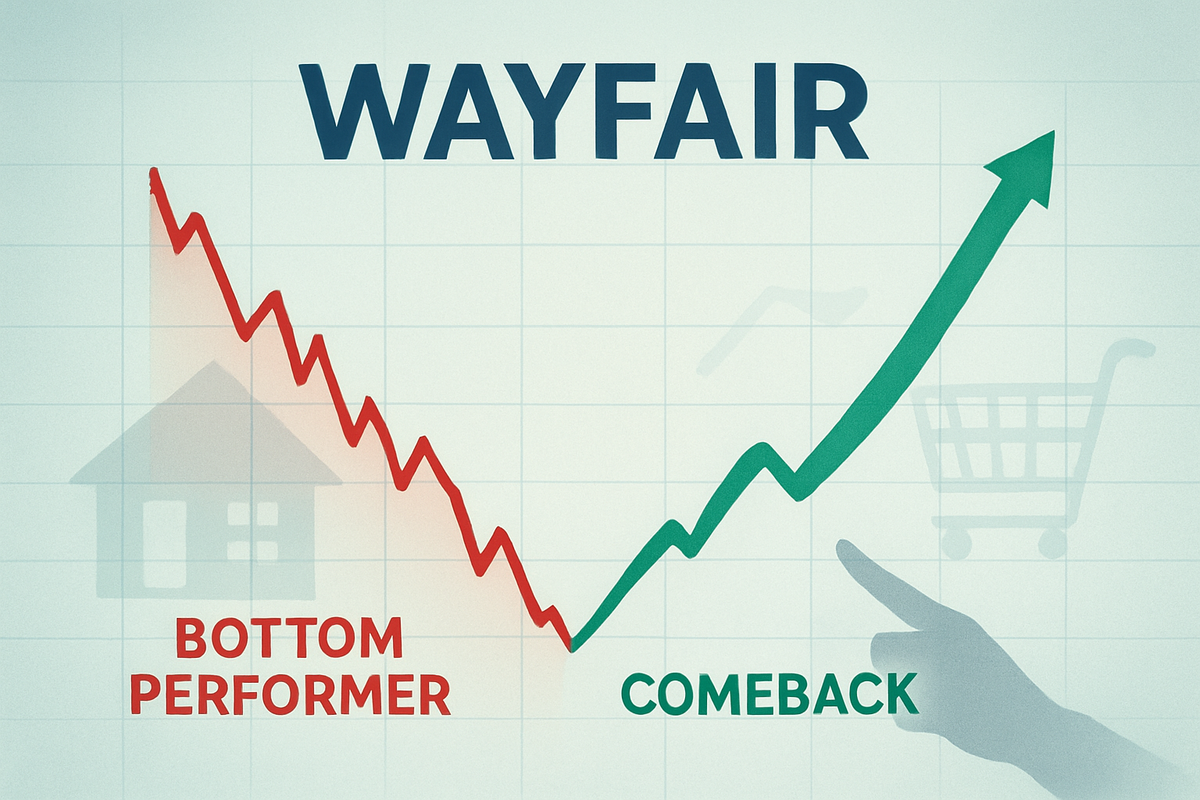
Wayfair (NYSE: W), the online home goods retailer, has been a name synonymous with market volatility, experiencing a rollercoaster of performance over the past year. While it languished as a "bottom performer" for much of 2024 and early 2025, recent strong third-quarter results and a wave of analyst upgrades have propelled its stock into a dramatic resurgence. Amidst this remarkable turnaround, a significant development emerged today, November 14, 2025: investment firm Glenview Capital Management has fully divested its position in Wayfair, a move that concluded in the third quarter of 2025, just before the company's recent rally.
This disclosure, detailed in Glenview Capital's 13F filing today, casts a fascinating light on the divergent perspectives of institutional investors and the rapidly evolving market sentiment around Wayfair. The hedge fund's exit, occurring prior to the stock's recent ascent, highlights the challenging landscape of e-commerce investing and the often-unpredictable nature of market recoveries.
A Timely Exit Amidst a Turnaround Story
Glenview Capital Management's decision to completely exit its stake in Wayfair (NYSE: W) during the third quarter of 2025 marks a notable moment in the investment landscape. This divestment was publicly disclosed today, November 14, 2025, through the firm's mandatory 13F filing. The timing is particularly intriguing, as Wayfair's stock has recently staged a significant rally, moving from a prolonged period of underperformance to becoming a market darling in early November 2025.
For much of 2024 and extending into the first half of 2025, Wayfair struggled, characterized by analysts and investors alike as a "bottom performer." The company's shares plunged considerably, facing macroeconomic headwinds such as fluctuating consumer spending, persistent inflationary pressures, and intense competition from retail behemoths like Amazon (NASDAQ: AMZN), Walmart (NYSE: WMT), and Home Depot (NYSE: HD). By April 2025, the stock had dipped near its 52-week low, reflecting a nearly 46% decline over the preceding year. This sustained pressure led to some analysts rating Wayfair as a "clear sell" as late as July 2025, citing unprofitability and a steep valuation despite limited growth prospects. It was against this backdrop of sustained underperformance that Glenview Capital likely made its decision to liquidate its position.
However, the narrative for Wayfair shifted dramatically in late 2025. The company delivered stronger-than-expected third-quarter 2025 financial results, reporting revenues of $3.117 billion and adjusted earnings per share of $0.70. These positive results, coupled with the appointment of Hal Lawton, CEO of Tractor Supply Company (NASDAQ: TSCO), to its board of directors on November 6, 2025, ignited a significant rally. Bank of America (NYSE: BAC) upgraded Wayfair from "Neutral" to "Buy" with an increased price target of $130, while RBC Capital also raised its price target to $86. As of November 10, 2025, Wayfair's stock had soared 145% since the beginning of the year, reaching a new 52-week high of $112.88 per share. The disclosure of Glenview Capital's exit, therefore, coincides with a period of robust positive momentum for Wayfair, suggesting the fund's divestment occurred before this recent surge, possibly missing out on substantial gains.
Implications for Wayfair and the E-commerce Landscape
Glenview Capital's exit from Wayfair (NYSE: W) could be interpreted in several ways, with varying implications for the online retailer and its competitors. For Wayfair itself, the immediate impact of a single hedge fund's divestment might be overshadowed by the recent positive momentum from its strong Q3 earnings. However, a large institutional investor's complete withdrawal can sometimes signal underlying concerns that might not be immediately apparent to the broader market, especially if the decision was made based on a long-term view that predates the recent positive news cycle. It could also suggest that Glenview Capital saw limited upside potential from their perspective, even if the short-term outlook has improved.
On the flip side, Wayfair's recent resurgence, driven by better-than-expected financial performance and strategic board appointments, positions the company as a potential "winner" in the evolving e-commerce home goods market. If Wayfair can sustain its profitability and growth trajectory, it could solidify its market share against competitors. The analyst upgrades from firms like Bank of America and RBC Capital indicate a renewed confidence in Wayfair's ability to navigate macroeconomic challenges and fierce competition. This turnaround could attract new institutional investors looking to capitalize on its perceived growth story, effectively replacing funds like Glenview Capital.
Competitors in the home goods and e-commerce space, such as Amazon (NASDAQ: AMZN), Walmart (NYSE: WMT), Target (NYSE: TGT), and specialty retailers like Overstock.com (NASDAQ: OSTK), will be closely watching Wayfair's trajectory. If Wayfair continues its upward trend, it could intensify competition for market share in the furniture and home decor segments, potentially putting pressure on their pricing strategies and marketing efforts. Conversely, if Wayfair's recent rally proves to be short-lived, it might reinforce the challenges inherent in the online home goods sector, potentially benefiting more diversified retailers or those with stronger brick-and-mortar presences. The event underscores the dynamic nature of retail, where even established players face constant pressure to innovate and adapt.
Broader Significance and Industry Trends
Glenview Capital's exit from Wayfair (NYSE: W) and Wayfair's subsequent stock rally offer a microcosm of the broader shifts and challenges within the e-commerce and home goods sectors. This event fits into the larger industry trend of post-pandemic normalization, where the accelerated growth of online retail during lockdowns has given way to a more discerning consumer environment. Companies that thrived during the pandemic-induced e-commerce boom are now grappling with higher customer acquisition costs, fluctuating consumer spending patterns, and intense competition, forcing many to prioritize profitability over sheer growth. Wayfair's earlier struggles as a "bottom performer" were a direct reflection of these broader industry headwinds, impacting numerous pure-play e-commerce businesses.
The potential ripple effects on competitors and partners are significant. If Wayfair's turnaround is sustainable, it could signal a renewed vigor in the online home furnishings market, potentially prompting competitors to reassess their own digital strategies and operational efficiencies. Partners, including suppliers and logistics providers, might see increased demand and stability from Wayfair, while others might face pressure to align with new market leaders. Regulatory or policy implications are less direct in this specific event, but the overall health of the e-commerce sector remains a point of interest for policymakers concerned with fair competition, data privacy, and labor practices in the gig economy that often underpins online retail.
Historically, the market has seen numerous instances of institutional investors divesting from companies just before a significant turnaround, or conversely, holding on through prolonged periods of underperformance only to see a recovery. This situation with Glenview Capital and Wayfair could draw comparisons to other highly volatile growth stocks that have experienced dramatic swings based on shifting investor sentiment and evolving market conditions. It highlights the inherent difficulty in timing the market and the often-contrarian nature of successful investing. The event underscores that even sophisticated institutional investors can make calls that, in hindsight, appear to miss a significant inflection point, emphasizing the complexity of predicting market movements in a rapidly changing economic landscape.
What Comes Next for Wayfair and the Market
Looking ahead, the immediate focus for Wayfair (NYSE: W) will be on sustaining the momentum generated by its strong third-quarter 2025 results. In the short term, investors will be closely watching for continued positive guidance, evidence of sustained profitability, and further analyst upgrades. The market will be keen to see if the recent surge is a true inflection point or merely a temporary bounce in a historically volatile stock. Wayfair's ability to manage inventory effectively, optimize its supply chain, and attract new customers while retaining existing ones will be crucial. The appointment of Hal Lawton to the board suggests a strategic pivot towards leveraging experienced leadership to navigate complex retail challenges, which could translate into operational improvements and enhanced shareholder value.
In the long term, Wayfair faces the ongoing challenge of differentiating itself in a crowded e-commerce market. Potential strategic pivots could include further expansion into private label brands, enhancing personalized shopping experiences through AI, or even exploring partnerships with brick-and-mortar retailers to offer a hybrid shopping model. Market opportunities may emerge from continued growth in the home renovation and furnishing sectors, especially if housing markets stabilize and consumer confidence improves. However, challenges persist, including intense price competition, rising logistics costs, and the ever-present threat of economic downturns impacting discretionary spending on home goods.
Potential scenarios and outcomes for Wayfair vary. A bullish scenario sees the company continuing its path to consistent profitability, expanding its market share, and solidifying its position as a dominant force in online home furnishings. This would likely involve further stock appreciation and continued institutional investor interest. A more neutral scenario might see Wayfair's stock stabilize within a certain range, reflecting a balanced view of its growth prospects and inherent market risks. A bearish scenario, though less likely given recent performance, could involve a return to unprofitability, increased competition eroding margins, or broader economic headwinds derailing its recovery, potentially leading to another period of underperformance.
A Comprehensive Wrap-Up: Navigating Volatility and Opportunity
The story of Wayfair (NYSE: W) in late 2025 is a compelling narrative of market volatility, strategic shifts, and the intricate dance between corporate performance and investor sentiment. The key takeaway from this event is the stark contrast between Wayfair's prolonged period as a "bottom performer" and its recent, dramatic resurgence, underscored by Glenview Capital's timely—or perhaps untimely, depending on perspective—exit from its portfolio. This highlights the dynamic nature of financial markets, where fortunes can shift rapidly, and even sophisticated investors can find themselves on different sides of a major inflection point.
Moving forward, the market will be closely assessing Wayfair's ability to build upon its strong third-quarter results. Investors should watch for consistent profitability, revenue growth, and further strategic announcements that could solidify its competitive position. The company's efforts to enhance operational efficiency, manage supply chain complexities, and innovate its customer experience will be critical determinants of its long-term success. The broader e-commerce landscape will also remain a key factor, with macroeconomic conditions and consumer spending trends continuing to influence discretionary purchases of home goods.
The lasting impact of this event lies in its illustration of investment risk and reward. Glenview Capital's divestment, made during a period of Wayfair's underperformance, serves as a reminder that even well-researched decisions can precede significant market shifts. Conversely, Wayfair's recent rally demonstrates the potential for resilient companies to stage comebacks, rewarding investors who maintain conviction or identify turning points. The coming months will reveal whether Wayfair can transform its recent momentum into sustained growth, cementing its place as a leader in the competitive online home goods market.
This content is intended for informational purposes only and is not financial advice






